ATTRACTIONS
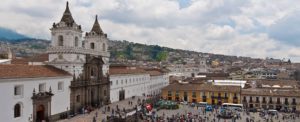 Quito is the capital and the largest city of Ecuador. It is the second-highest official capital city in the world, after La Paz, and the one which is closest to the equator. It is located in the Guayllabamba river basin, on the eastern slopes of Pichincha, an active stratovolcano in the Andes Mountains. The historic center of Quito is one of the largest, least-altered and best-preserved historic centers in the Americas, a true heritage treasure that houses churches, museums and cultural centers that will allow you to discover, through a wonderful trip, the history of Ecuador and its richness in terms of cultural and natural diversity. Surrounded by spectacular mountains and volcanoes, Quito presents wonderful landscapes no matter where you look at it. Walk through its old streets, surrounded by flowery balconies with its bohemian air, the Church of the Company with its internal treasures, El Panecillo with its spectacular view, the Foch area with its varied offer of nightlife and gastronomy; or, the City of the Middle of the World located a few minutes from the center, are just some of the places that await your visit. Specialists consider that Quito is one of the best destinations to discover in the world, proof of this are the multiple distinctions it has received, such as the Trip Advisor Traveler Choice on three occasions. In addition, it has been worthy of some recognition, such as: being declared Ibero-American Capital of Culture; designated as South America’s Leading Destination by the World Travel Awards and, finalist in the contest of the seven cities Wonders of the World. Quito was declared by UNESCO as the first Cultural Heritage of Humanity in 1978. Walking through its streets is to be amazed by an architecture that will leave you speechless and has infinity of places to discover and activities to be done that will surprise you.
Quito is the capital and the largest city of Ecuador. It is the second-highest official capital city in the world, after La Paz, and the one which is closest to the equator. It is located in the Guayllabamba river basin, on the eastern slopes of Pichincha, an active stratovolcano in the Andes Mountains. The historic center of Quito is one of the largest, least-altered and best-preserved historic centers in the Americas, a true heritage treasure that houses churches, museums and cultural centers that will allow you to discover, through a wonderful trip, the history of Ecuador and its richness in terms of cultural and natural diversity. Surrounded by spectacular mountains and volcanoes, Quito presents wonderful landscapes no matter where you look at it. Walk through its old streets, surrounded by flowery balconies with its bohemian air, the Church of the Company with its internal treasures, El Panecillo with its spectacular view, the Foch area with its varied offer of nightlife and gastronomy; or, the City of the Middle of the World located a few minutes from the center, are just some of the places that await your visit. Specialists consider that Quito is one of the best destinations to discover in the world, proof of this are the multiple distinctions it has received, such as the Trip Advisor Traveler Choice on three occasions. In addition, it has been worthy of some recognition, such as: being declared Ibero-American Capital of Culture; designated as South America’s Leading Destination by the World Travel Awards and, finalist in the contest of the seven cities Wonders of the World. Quito was declared by UNESCO as the first Cultural Heritage of Humanity in 1978. Walking through its streets is to be amazed by an architecture that will leave you speechless and has infinity of places to discover and activities to be done that will surprise you.
 Cuenca. Considered as the third most important city of Ecuador; its natural, architectural characteristics and the quality of life, are reasons why it has been recognized as the best destination for people from all over the world. Walk through its cobbled streets and visit its many imposing churches and museums or contemplate its terracotta rooftops and flowery balconies, it will be a unique experience that will captivate you, while its stories and legends will transport you in time through a magical journey. In the year of 1982, the Historic Center of Cuenca was recognized as a Cultural Heritage of the Ecuadorian State and, in 1999, it was declared by UNESCO as a Cultural Heritage of Humanity. Along with the lower cost of living comes the higher quality of life for families and retirees. Not only does Cuenca have an abundance of Universities, including University courses in Spanish for expats, but the local schools are excellent and the community places a very high value on education in general.
Cuenca. Considered as the third most important city of Ecuador; its natural, architectural characteristics and the quality of life, are reasons why it has been recognized as the best destination for people from all over the world. Walk through its cobbled streets and visit its many imposing churches and museums or contemplate its terracotta rooftops and flowery balconies, it will be a unique experience that will captivate you, while its stories and legends will transport you in time through a magical journey. In the year of 1982, the Historic Center of Cuenca was recognized as a Cultural Heritage of the Ecuadorian State and, in 1999, it was declared by UNESCO as a Cultural Heritage of Humanity. Along with the lower cost of living comes the higher quality of life for families and retirees. Not only does Cuenca have an abundance of Universities, including University courses in Spanish for expats, but the local schools are excellent and the community places a very high value on education in general.
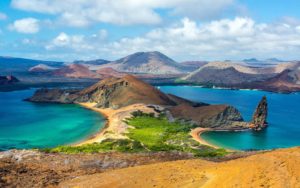 Galapagos Islands This is one of the few places in the world where you can get very close to the wildlife. The Galapagos Islands is a volcanic archipelago in the Pacific Ocean. It’s considered one of the world’s foremost destinations for wildlife-viewing. A province of Ecuador, it lies about 1,000km off its coast. Its isolated terrain shelters a diversity of plant and animal species, many found nowhere else. These Islands were discovered by accident in the year 1535 being called firstly as “Enchanted Islands”. In 1835 it was the well-known English naturalist Charles Darwin who fell in love with this place, which he used as a natural laboratory and his observation of Galapagos’ species later inspired his ‘Theory of Evolution’. In 1978, UNESCO declared them Natural Heritage of Humanity. The Galapagos Islands alone receive over 200,000 visitors per year, but the islands are actually in danger of being over-touristed. The archipelago, considered an earthly paradise with 13 major islands, 5 medium islands and 215 islets, is the home of marine species and exotic birds. Swimming among sharks, walking alongside with gigantic sea tortoises, get up close and personal with playful sea lions, watching the adorable blue-footed boobies dance and dazzling yourself with unique landscapes in the world are some of the activities you must do to discover the wonders and beauty of the legendary and enchanting Galapagos Islands. There is no other place like it in the world so make your experience unique and worth remembering.
Galapagos Islands This is one of the few places in the world where you can get very close to the wildlife. The Galapagos Islands is a volcanic archipelago in the Pacific Ocean. It’s considered one of the world’s foremost destinations for wildlife-viewing. A province of Ecuador, it lies about 1,000km off its coast. Its isolated terrain shelters a diversity of plant and animal species, many found nowhere else. These Islands were discovered by accident in the year 1535 being called firstly as “Enchanted Islands”. In 1835 it was the well-known English naturalist Charles Darwin who fell in love with this place, which he used as a natural laboratory and his observation of Galapagos’ species later inspired his ‘Theory of Evolution’. In 1978, UNESCO declared them Natural Heritage of Humanity. The Galapagos Islands alone receive over 200,000 visitors per year, but the islands are actually in danger of being over-touristed. The archipelago, considered an earthly paradise with 13 major islands, 5 medium islands and 215 islets, is the home of marine species and exotic birds. Swimming among sharks, walking alongside with gigantic sea tortoises, get up close and personal with playful sea lions, watching the adorable blue-footed boobies dance and dazzling yourself with unique landscapes in the world are some of the activities you must do to discover the wonders and beauty of the legendary and enchanting Galapagos Islands. There is no other place like it in the world so make your experience unique and worth remembering.
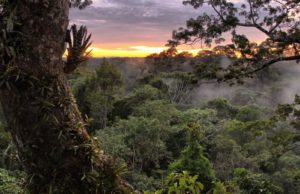 Yasuni National Park The Yasuni National Park, is located in the eastern center of the Amazonian provinces of Orellana and Pastaza and is the largest protected area of continental Ecuador. It was created on July 26, 1979, with the one million hectares hosting an important natural and cultural heritage. It is considered one of the most biodiverse places on the planet so it has been scientifically qualified as “Refuge of the Pleistocene”.
Yasuni National Park The Yasuni National Park, is located in the eastern center of the Amazonian provinces of Orellana and Pastaza and is the largest protected area of continental Ecuador. It was created on July 26, 1979, with the one million hectares hosting an important natural and cultural heritage. It is considered one of the most biodiverse places on the planet so it has been scientifically qualified as “Refuge of the Pleistocene”.
The humid tropical forest of the Yasuni is a privileged place in election to other regions of the planet. Due to a combination of geographical, geological, meteorological and historical factors; The tropical jungles of Yasuni are considered the most biodiverse and richest on the planet, there is no other region in the world that offers the necessary conditions for such a vast and complex development of life.
 Basilica del Voto Nacional This monumental Basilica del Voto Nacional is the most important work of neo-Gothic Ecuadorian architecture in Ecuador and one of the most representative of the American continent. It was once the largest in the New World. The building is noted for its grotesques in the form of native Ecuadorian animals such as armadillos, iguana, and tortoises. The Basilica is 140 m (460 ft) long and 35 m (115 ft) wide. It is 30 m (98 ft) high in the sanctuary, 15 m (49 ft) high in the votive chapels, 74 m (243 ft) high in the transept, and 115 m (377 ft) high in the two frontal towers. In the sanctuary, there are fourteen bronze images representing eleven apostles and three evangelists. In the crypt, there is a pantheon containing the remains of several heads of state. Some visitors, who are not afraid of heights, are welcome to climb all the way up onto the roof of the building to enjoy a hundred and seventeen meter panoramic view of the city and the surrounding mountains. Entrance fees to a few parts of the church is asked, but this gives visitors access to a large portion of the church, including the twenty four chapels, clock tower and bell tower. It is one of the most breathtaking structures in all Ecuador.
Basilica del Voto Nacional This monumental Basilica del Voto Nacional is the most important work of neo-Gothic Ecuadorian architecture in Ecuador and one of the most representative of the American continent. It was once the largest in the New World. The building is noted for its grotesques in the form of native Ecuadorian animals such as armadillos, iguana, and tortoises. The Basilica is 140 m (460 ft) long and 35 m (115 ft) wide. It is 30 m (98 ft) high in the sanctuary, 15 m (49 ft) high in the votive chapels, 74 m (243 ft) high in the transept, and 115 m (377 ft) high in the two frontal towers. In the sanctuary, there are fourteen bronze images representing eleven apostles and three evangelists. In the crypt, there is a pantheon containing the remains of several heads of state. Some visitors, who are not afraid of heights, are welcome to climb all the way up onto the roof of the building to enjoy a hundred and seventeen meter panoramic view of the city and the surrounding mountains. Entrance fees to a few parts of the church is asked, but this gives visitors access to a large portion of the church, including the twenty four chapels, clock tower and bell tower. It is one of the most breathtaking structures in all Ecuador.
TRAVEL ADVENTURE
Ecuador is one of the world’s most exciting travel destinations and a place of countless natural and cultural wonders. It has a coastline along the Pacific Ocean, which provides many beaches with white sand and clear blue water. You’ll find a fair chunk of the Amazon Rainforest here, the amazing Andes. A favorite place for adventure seekers. Ecuador is the one of the most biodiverse countries on Earth. There’s plenty to do here, like zip lining, white water rafting, trekking, canyoneering and swinging out into the mountains. For a stronger adrenaline kick, check out the nearby El Vuelo del Condor. Here you’re strapped into a much longer swing, so you swing further out into the mountain valley, far beyond the mountain edge, and back. One of the greatest cycling adventures you can have in Ecuador is the Quilotoa Loop, a famous trekking destination in Ecuador. It’s a bumpy, ring-shaped road that travels from the Panamericana far into the backcountry of the Cotopaxi province. 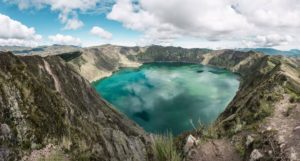 The climax point of the Quilotoa Loop is the Quilotoa Lake, which is a volcanic crater bed of emerald green water. You can rent a kayak and traverse the entire length of the lake in around 30 minutes. It’s a lot of fun, both for the remarkable views. Giant volcanic rock walls shoot up into the sky along a raging river in Baños, Ecuador. The cliffs were formed centuries ago by magma flows from the nearby Tungurahua Volcano. These cooled lava rocks create a climber’s paradise in San Martin, just outside of town. Rock climbing in Baños is a fun way to spend the day.
The climax point of the Quilotoa Loop is the Quilotoa Lake, which is a volcanic crater bed of emerald green water. You can rent a kayak and traverse the entire length of the lake in around 30 minutes. It’s a lot of fun, both for the remarkable views. Giant volcanic rock walls shoot up into the sky along a raging river in Baños, Ecuador. The cliffs were formed centuries ago by magma flows from the nearby Tungurahua Volcano. These cooled lava rocks create a climber’s paradise in San Martin, just outside of town. Rock climbing in Baños is a fun way to spend the day.
 At 6,268 meters, Chimborazo is the tallest mountain in Ecuador. Since the Earth bulges near the equator, this snowcapped giant is not only the highest mountain in Ecuador, but also the highest in the world if measured from the core of the Earth outward to the peak. If you are up for the challenge you can summit this extinct volcano. Before attempting this hike, climbers must acclimate their bodies to high altitude. Cotopaxi is Ecuador’s highest active volcano.The best way to get a clear view in the morning is by camping in Cotopaxi National Park, and if you are up for the challenge you can climb to the summit.
At 6,268 meters, Chimborazo is the tallest mountain in Ecuador. Since the Earth bulges near the equator, this snowcapped giant is not only the highest mountain in Ecuador, but also the highest in the world if measured from the core of the Earth outward to the peak. If you are up for the challenge you can summit this extinct volcano. Before attempting this hike, climbers must acclimate their bodies to high altitude. Cotopaxi is Ecuador’s highest active volcano.The best way to get a clear view in the morning is by camping in Cotopaxi National Park, and if you are up for the challenge you can climb to the summit.
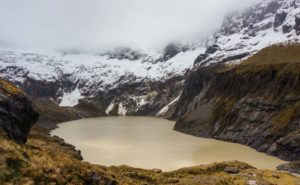 The hike to the Yellow Lagoon of El Altar is a real off the beaten path adventure. It’s a 3-4 day hike that takes you through Sangay National Park to reach El Altar. It’s a truly spectacular extinct volcano located in the heart of the Ecuadorian Andes. Up to 12 snow-capped peaks over 5,000mts (16,000ft) protect the yellow lagoon forming a C-shape, with the open side facing a magnificent glacial valley.
The hike to the Yellow Lagoon of El Altar is a real off the beaten path adventure. It’s a 3-4 day hike that takes you through Sangay National Park to reach El Altar. It’s a truly spectacular extinct volcano located in the heart of the Ecuadorian Andes. Up to 12 snow-capped peaks over 5,000mts (16,000ft) protect the yellow lagoon forming a C-shape, with the open side facing a magnificent glacial valley.
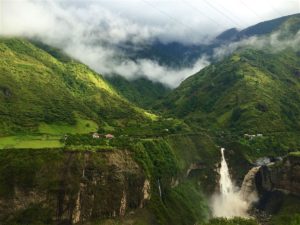 Baños is a fun way to spend the day learning some new skills and challenging yourself. It is a popular tourist destination in Ecuador due to its natural environment (it is home to more than 60 waterfalls) and its adventure sports. Locals and visitors alike undertake rafting, kayaking, canyoneering, bridge jumping, hiking, biking and horseback riding. Just outside of the town of Baños you will find Canyon Rio Blanco. It’s raging river and high waterfalls offer some fun opportunities to rappel and zip line. You’ll make your way through the canyon being surrounded by high rock walls covered with thick rainforest vegetation. Here you will rappel down 5 waterfalls, one of which is over 30 meters (100 ft) tall! People come from all over the world to dive Darwin’s Enchanted Isles for a chance to get up close with hammerheads, mola molas, sea lions, whale sharks, marine iguanas and manta rays, among others. While shore diving is a possibility, the best way to get the most out of your time in the islands is to take a liveaboard diving trip to the more remote islands. If you want to check off your Big Ocean Creatures Bucket List, this is the best place to do it. Ecuador’s coast is a composition of beautiful lush green mangrove forests, a jungle, crystal clear waters, stunning white sandy beaches and many quaint fishing villages. The coastline of Ecuador plays a big role in Ecuador’s economy and cuisine, delivering tons of seafood daily and entertaining the many tourists that visit each year. Ecuador offers up a huge serving of adventure and prepare to be entertained by its amazing wonders.
Baños is a fun way to spend the day learning some new skills and challenging yourself. It is a popular tourist destination in Ecuador due to its natural environment (it is home to more than 60 waterfalls) and its adventure sports. Locals and visitors alike undertake rafting, kayaking, canyoneering, bridge jumping, hiking, biking and horseback riding. Just outside of the town of Baños you will find Canyon Rio Blanco. It’s raging river and high waterfalls offer some fun opportunities to rappel and zip line. You’ll make your way through the canyon being surrounded by high rock walls covered with thick rainforest vegetation. Here you will rappel down 5 waterfalls, one of which is over 30 meters (100 ft) tall! People come from all over the world to dive Darwin’s Enchanted Isles for a chance to get up close with hammerheads, mola molas, sea lions, whale sharks, marine iguanas and manta rays, among others. While shore diving is a possibility, the best way to get the most out of your time in the islands is to take a liveaboard diving trip to the more remote islands. If you want to check off your Big Ocean Creatures Bucket List, this is the best place to do it. Ecuador’s coast is a composition of beautiful lush green mangrove forests, a jungle, crystal clear waters, stunning white sandy beaches and many quaint fishing villages. The coastline of Ecuador plays a big role in Ecuador’s economy and cuisine, delivering tons of seafood daily and entertaining the many tourists that visit each year. Ecuador offers up a huge serving of adventure and prepare to be entertained by its amazing wonders.
THE PEOPLE
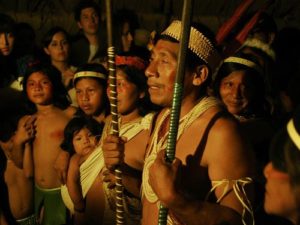 Of all the natural wonders found in Ecuador, it is the people that make an Ecuadorian experience truly memorable and rewarding. Although close to half live beneath the poverty level, most people you meet are happy and generous. Ecuadorian people are very welcoming and friendly.
Of all the natural wonders found in Ecuador, it is the people that make an Ecuadorian experience truly memorable and rewarding. Although close to half live beneath the poverty level, most people you meet are happy and generous. Ecuadorian people are very welcoming and friendly.
Ecuadorians are people identified with Ecuador, a country in South America, its citizens or their descendants abroad who identify with the Ecuadorian culture and descent. Ecuador is a multiethnic society, a home to people of various ethnic origins; as a result, Ecuadorians do not equate their nationality with their ethnicity, but rather their allegiance or affinity for Ecuador. Majority of Ecuadorians trace their origins to one or more of three geographical sources of human migrations to the territory of modern Ecuador: the pre-Hispanic indigenous populations who settled the region over 15,000 years ago, the Europeans (principally Spaniards which are also the source of the Spanish language) who arrived over five centuries ago, and ultimately the sub-Saharan Africans who were imported to New Spain as slaves during the same period. The mixing of two or more of these three groups established other mixed ethnic groups.
Ecuador’s mainstream culture is defined by its Hispanic mestizo majority, and, like their ancestry, it is traditionally of Spanish heritage, influenced in different degrees by Amerindian traditions and in some cases by African elements. The various groups of people who have come to settle in Ecuador – from Europe, Africa and elsewhere – and the country’s many indigenous groups have all contributed to Ecuadorian culture as it is today. From the rich and varied food traditions to customs for celebrating various holidays and religious festivities, Ecuador’s culture is a pleasure to explore.